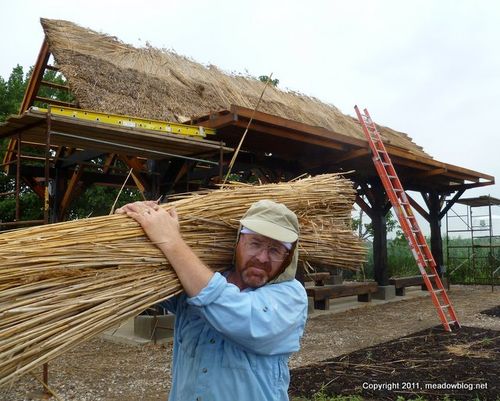
NJMC staffer Jim Wright, who keeps this blog, also writes a column every other Thursday for The South Bergenite. His latest, about a thatcher building a roof out of Phragmites in the Meadowlands, is below:
Most people don’t have much use for Phragmites, the tall, thick reed that has taken over much of the Meadowlands over the past 75 years.
But don’t count William Cahill among the invasive plant’s detractors.
Cahill is a thatcher — a craftsman originally from Galway, Ireland, who in recent weeks has been using Phrags to build the roof of a pavilion at River Barge Park, the New Jersey Meadowlands Commission’s new 5.5-acre waterside park and marina in Carlstadt.
It turns out that one of Meadowlands’ most persistent plants is also one of the most environmentally friendly building materials.
Full story continues below.
“You can’t get anything greener than this, especially when you consider that it’s a locally grown material you’re using,” said Cahill in a recent interview at the building site, on the Hackensack River northeast of the Meadowlands Sports Complex.
“These shade structures are really beneficial in the summer,” according to Cahill. “There’s often a 15-degree difference in temperature when you’re under the thatch as opposed to being out in the open. It’s terrific insulation against the heat. The pores in the reed keep it cool.”
In all, 900 bundles of Phragmites were installed in seven layers on the 17-foot by 38-foot roof of the new Robert Ceberio Environmental Education Pavilion. Cahill says the roof should last more than 20 years — with a few routine repairs along the way.
Using Phragmites is in keeping with the commission’s efforts to use as many “green” materials as possible in the new park, including making benches from huge Southern Long Leaf yellow pine timbers rescued from three derelict barges.
Cahill, an Ohio resident, says he has built thatched roofs in 41 of the 50 United States in the quarter-century he has lived in America — using Phragmites from New Jersey for homes, gazebos, commercial buildings and outdoor structures as far away as Oklahoma.
The process is simple. Each autumn he harvests from 40 to 50 acres of Phragmites, then lets it dry over to the winter to eliminate the shrinkage factor.
“The Phrag grows back the next year, so it’s renewable,” he said. “And because you don’t get a build-up of dead Phrag each year, the fire hazard in the marsh is reduced.”
Cahill won the thatching contract for the River Barge Park after last year’s harvest was over, so he was able to use Meadowlands pragmatism for only part of the project — for the roof’s ridge. Phrags from South Jersey were used for the thatching itself.
“North Jersey, South Jersey — there’s no difference in the reed,” he said.
Although the reed is integral to Cahill’s livelihood, his love of Phragmites goes only so far.
When I mentioned to Cahill that I thought Phragmites was nasty stuff — and how a couple of years ago, my right forearm got infected from a Phragmites splinter — he just laughed and held up a hand and displayed a variety of ugly little nicks and cuts.
“I always have tweezers handy,” he said. “It’s a tough material when it spikes you, definitely.”
For more information on thatched roofs, go to Cahill’s website, roofthatch.com.

Most people don’t have much use for Phragmites, the tall, thick reed that has taken over much of the Meadowlands over the past 75 years.
Most people don’t have much use for Phragmites, the tall, thick reed that has taken over much of the Meadowlands over the past 75 years.
yatak odası–evim şahane–mobilya modelleri–bedava chat–chat–islami rüya tabirleri–mynet
Pingback: More Hurricane Sandy Repairs: River Barge Park | The Meadowlands Nature Blog
TLG Roofing Melbourne offers leading re-roofing expertise, making your roof restoration project a breeze. We provide Roof Restoration Melbourne service with the help of our skilled professionals. With a team of specialists, we cover all roofing aspects at best price.
This is a great post, very interesting points and I have enjoyed immeasurably. Lots of thanks!
Thank You For this amazing blog!